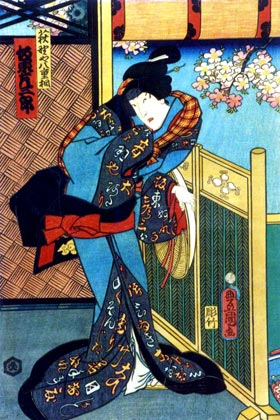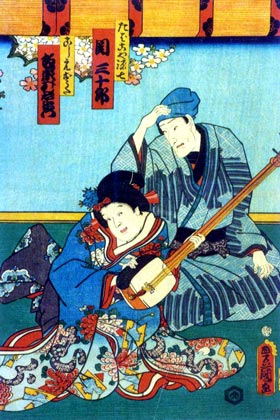| YAEGIRI KURUWA BANASHI |
| Play titles | Komochi Yamanba Yaegiri Kuruwa Banashi |
| Authors | Chikamatsu Monzaemon |
| History |
The puppet play "Komochi Yamanba" was premiered in the 7th lunar month of 1712 in Ôsaka at the Takemotoza. It was adapted for Kabuki more than 8 decades later, in the 3rd lunar month of 1795 in Ôsaka at the Kado no Shibai [more details]. It was staged for the first time in Edo in the 9th lunar month of 1810 at the Nakamuraza [casting]. |
| Structure |
"Komochi Yamanba" was originally made up of 5 acts. The most famous act, the second one, is still part of the current Kabuki reportoire. It is commonly called "Yaegiri Kuruwa Banashi" or "Shaberi". |
| Key words |
Gidayû Kyôgen Jidaimono Minamoto Yorimitsu Shaberi Shitennômono Tachimawari Yamanba Yamanbamono |
| Summary |
Introduction scene (usually ommitted) The play opens in the palace of Iwakura no Kanefuyu. Kanefuyu's daughter Princess Omodaka is in love with Minamoto no Yorimitsu (nicknamed Raikô), who had to run away because of an evil plot led by Kiyohara no Takafuji. Takafuji has a crush on Princess Omodaka and he has sent his emissary Ôta Jûrô to try to convince the Princess to forget about Raikô and accept to become Takafuji's lover. The Princess is depressed and all her ladies-in-waiting, including the comical koshimoto Outa, do their best to cheer her up. They've invited a tobacco peddler, named Tabakoya Genshichi, to tell some tales about tobacco. Ôta Jûrô arrives on stage and tries to abduct the princess. Genshichi creates a diversion by inviting Ôta Jûrô to smoke with him a very special tobacco, which is said to attract women. Jûrô smokes too much and becomes sick. He leaves the stage via the hanamichi. Genshichi, who is a talented singer and shamisen player, starts to sing a song about the pleasure quarters. In front of Kanefuyu's palace gate When the curtain is drawn, the scene represents the walls of Iwakura no Kanefuyu's palace. We can see beautiful cherry and pine trees overhanging the garden wall. the courtesan Oginoya Yaegiri appears on the hanamichi. She can hear the song, which was written by her husband, whom she's looking for. She needs to enter the palace, and in order to do this, she tries to distract some servants' attention. She claims to be a letter writer and a storyteller, offering her services to this palace. Outa opens the gate and invites Yaegiri to entertain them. In Kanefuyu's palace Stage assistants remove the props, which symbolize the palace wall. We are now within the palace. The reunion of Yaegiri and Sakata Tokiyuki, the real name of Genshichi, occurs in front of Princess Omodaka. The two are extremely surprised to meet again. Tokiyuki has left her to run for Monobe no Heita, the murderer of his father Sakata Zenji Sadatoki. Yaegiri, who is really angry, wonders why he is now entertaining a princess in her palace. Princess Omodaka asks her to tell her story. This is the beginning of Yaegiri's shaberi, the highlight of this act. She narrates her life as a courtesan in the pleasures quarter, at the Oginoya brothel in Ôsaka. She had a rival in love, another courtesan named Odamaki. One day, their rivalry led to an incredible clash, full of insults and blows, which involved courtesans, servants and even the cook of the brothel. Yaegiri mimes her story while the Gidayû singer sings it. Outa mimes the others characters of Yaegiri's story. Princess Omodaka is delighted and invites Yaegiri to join her later in an inner room to tell more stories. The Princess and her ladies-in-waiting withdraw from the stage, leaving Yaegiri and Tokiyuki alone. She refuses to talk to the one who has abandoned the family home. There is no way for Yaegiri to forgive a man, who spend his time in palaces in the company of women instead of looking for the murderer of his father. Moreover, somebody else has already took the revenge for the death of Tokiyuki's father. Shiragiku, one of Princess Omodaka's ladies-in-waiting, appears on stage. She is the younger sister of Tokiyuki. She found Monobe on Heita in an inn. She received the help of the cook Kinosuke and they killed together the murderer. They were helped by Minamoto no Raikô, who took the cook into his service and gave him the name of Usui no Sadamitsu. Tokiyuki is shocked to hear that the vendetta is over and that he was absolutely useless. He decides to commit suicide on the spot, in front of the two women. His last words are about his powerful spirit, who will enter her wife after his death and make her a boy! The spirit takes possession of Yaegiri's body, who collapses behind a folding screen. Ôta Jûrô is back on stage with a group of soldiers. Their plan is to abduct Princess Omodaka but they are stopped by Shiragiku. The first tachimawari opposes Shiragiku and 8 spearmen. She easily defeats them and runs after them when they try to escape. Ôta Jûrô, firmly holding Princess Omodaka by her hand, is about to leave the palace when he is stopped by Yaegiri, who has just waken up. She intervenes between the two, frees the Princess and leaves her to Shiragiku's care. The two women exit the stage through the hanamichi. Yaegiri is no more a gracious courtesan. She is Yamanba, a powerful woman who looks like a demon. The second tachimawari starts, opposing Yamanba and soldiers holding branches adorned with cherry flowers. An amazing bukkaeri reveals her true nature and her new strength. She fights again Jûrô's and his troupe. At the climax of the tachimawari, she grabs a heavy stone basin and throw it upon her opponents. Stage assistants bring a three-stepped red-carpeted platform in the center of the stage. Yamanba climbs on the top of the platform for the final pose. The soldiers form a beautiful tableau while Jûrô and Yamanba strike their mie, bringing the play to its end. |
 |
 |
|
The actors Bandô Hikosaburô V, Bandô Muraemon I and Seki Sanjûrô III playing the roles of Oginoya Yaegiri, the koshimoto Outa and Tabakoya Genshichi in the drama "Komochi Yamanba", which was staged in the 2nd lunar month of 1861 at the Nakamuraza (print made by Utagawa Toyokuni III) |
|
|
|
| Contact | Main | Top | Updates | Actors | Plays | Playwrights | Programs | Links | FAQ | Glossary | Chronology | Illustrations | Prints | Characters | Derivatives | Theaters | Coming soon | News |